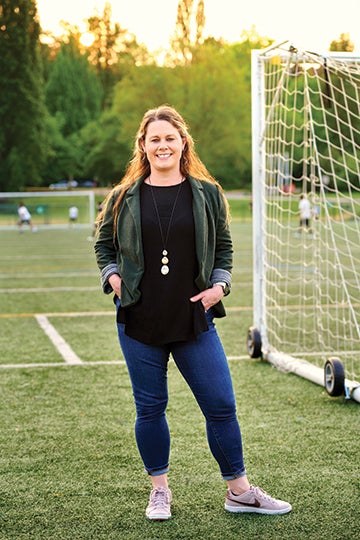Estrogen and Injury
Biomedical engineer Jenny Robinson studies the role hormones play in injury prevention and rehabilitation.
Summer 2023
By Rachel Fairbank

When Jenny Robinson ’09 was 12, she hurt her knee playing soccer. Over the next couple of years, as many of her teammates, including her sister and her cousin, sustained similar knee injuries, she developed a curiosity about the mechanism of sports injuries in female athletes, including the process of tissue regeneration and rehabilitation.
The complications stemming from the treatments of her injuries, which included hamstring issues and the development of post-traumatic osteoarthritis at the age of 16, made a big impact on her academic pursuits. “We all deserve treatment that doesn’t cause additional injury,” says Robinson.
As Robinson continued her studies, she realized that what had happened to her and other teammates was part of a larger pattern, one that included a lack of knowledge about the role hormones such as estrogen play in tissue remodeling and regeneration. “We know that hormones affect the cell cycle and the proliferation of cells,” Robinson says. “We also know that hormones impact collagen production and play a role in the action of degradative enzymes, which are responsible for breaking down tissues.”
Historically, gender differences in medicine have been under-studied due to a number of factors, which included a policy of excluding women from clinical trials due to safety concerns and the exclusive use of male mice in lab experiments to avoid complications caused by fluctuating hormone levels in female mice. This has led to a large gap in knowledge about the effects that hormone levels may play in a number of medical issues, including injury prevention and repair.
We know that at a macro scale, male and female tissues are structurally different. What we are interested in answering is how that might impact how a cell and tissue respond to certain cues.
“There is epidemiological evidence to suggest that during the follicular phase, when you have high estrogen, that’s when predominantly more ACL tears happen,” Robinson says. “We have some evidence to suggest that estrogen levels might impact cross-linking of the collagen, which impacts the stiffness of ligaments, but mechanistically, it’s still not a clear story.”
Robinson’s research uses engineered materials to answer some of these questions. “We’re interested in how the structure and the mechanics of a tissue might tell a cell to do things and can use our engineered materials to test these questions,” Robinson says. “We know that at a macro scale, male and female tissues are structurally different. What we are interested in answering is how that might impact how a cell and tissue respond to certain cues.”
From a clinical perspective, Robinson is hoping that this research can lead to a better understanding of how injuries heal and what impact hormones might have on the healing process. And as a former soccer player and the mother of a young daughter, she also brings a personal perspective to her work. “I would hope that my daughter is able to compete in high-performance sports and that coaches, staff and trainers will have a full awareness of the relationship of hormones to biomechanics in ways that could reduce injuries.”
Jenny Robinson was recently named an assistant professor and Endowed Chair in Women’s Sports Medicine and Lifetime Fitness at the University of Washington.
